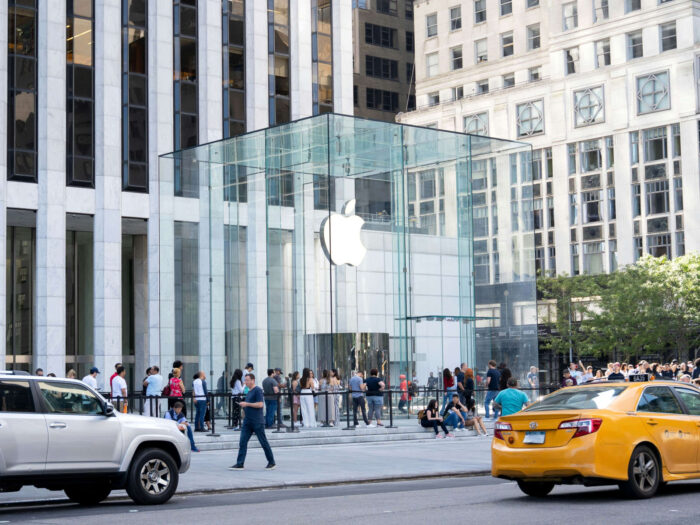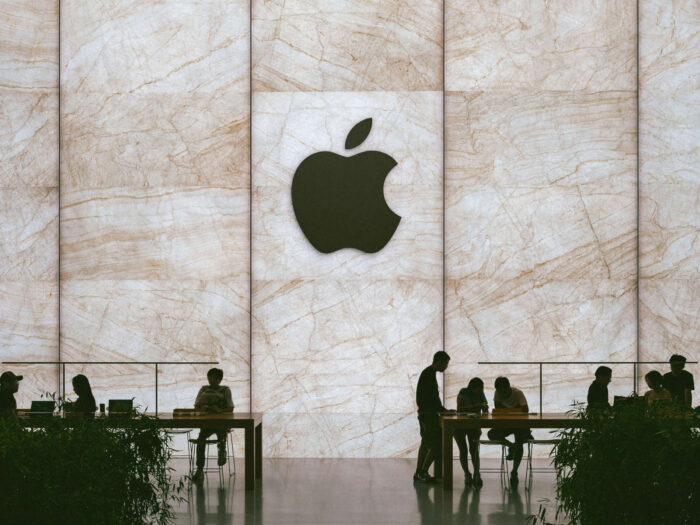
This Five Forces analysis of Apple Inc. gives insights into external factors influencing the business. Michael E. Porter’s Five Forces analysis model evaluates customers’ and suppliers’ power, the threat of substitutes and new entrants, and competitive rivalry.
This Five Forces analysis case sheds light on external factors affecting Apple’s vision statement and mission statement fulfillment under Tim Cook’s leadership, and competitive strategies and goals in markets for computer hardware and software, consumer electronics, and online services.
In this Five Forces analysis, external factors in Apple’s industry point to the intensity of competition or competitive rivalry, and the bargaining power of buyers or customers as primary forces in strategic planning.
Nonetheless, all five forces influence the business and its strategic decisions, together with the business effects of the industry and market trends discussed in the PESTLE/PESTEL analysis of Apple.
Competitive Rivalry or Competition with Apple (Strong Force)
Apple faces the strong force of competitive rivalry or competition. This component of Porter’s Five Forces analysis model determines the intensity of the influence that competitors have on each other. In Apple’s case, this influence is based on the following external factors:
- High aggressiveness of technology firms
- Low differentiation of many products
- Customers’ low switching cost
Competitors’ aggressiveness in innovation and marketing imposes a strong force in the information technology industry environment. In the market for consumer electronics, software, and Internet services, Apple competes with Google (Alphabet), Microsoft, Samsung, Sony, and others.
In the video-streaming market, Netflix, Disney, Amazon, and Facebook (Meta) compete with Apple TV Plus. Also relevant to this Five Forces analysis are other technology firms, such as IBM and Intel, which influence Apple’s competitive environment.
In terms of product differentiation, many products in the IT, consumer electronics, and online services market are similar in fulfilling specific purposes. For example, many popular apps are available for Android and iOS devices, and cloud storage services from Apple and other companies are similar and available to users on different platforms.
In this Five Forces analysis of Apple, such a condition creates a strong competitive force by making it easier for customers to switch to other sellers or providers of digital services and consumer electronics.
The low switching cost equates to the consequences of switching between providers. This factor means that it is easy for customers to switch from Apple to other brands, based on price, function, accessibility, network externalities, and related concerns.
The combination of these external factors in this part of the Five Forces analysis leads to tough competitive rivalry that is among the most significant considerations in Apple’s strategic management.
Bargaining Power of Customers/Buyers (Strong Force)
The bargaining power of buyers is strong in affecting Apple’s business. This component of Porter’s Five Forces analysis model determines how buyers’ purchasing decisions and related preferences and perceptions impact businesses. In Apple’s case, buyers’ strong bargaining power is based on the following external factors:
- Customers’ low switching costs
- Small size of individual buyers
- High availability of information to buyers
In the global market, it is relatively easy for many customers to change brands or service providers. This competitive factor adds to customers’ bargaining power in compelling Apple to ensure customer satisfaction.

On the other hand, each buyer’s purchase is small compared to the company’s total revenues. In this Five Forces analysis of Apple, such a condition makes customers weak at the individual level.
However, despite the small size of individual buyers, the availability of detailed comparative information about competing products empowers buyers when deciding to shift from Apple to other providers or brands.
This external factor of information availability enables buyers to exert a strong force in the industry, although promotional strategies and tactics in Apple’s marketing mix (4P) can communicate tailored information to persuade customers to buy the company’s products and not shift to competitors.
This part of the Five Forces analysis shows that Apple must include the bargaining power of buyers or customers as one of the most significant strategic variables influencing the business and its competitiveness.
Bargaining Power of Apple’s Suppliers (Weak to Moderate Force)
Apple Inc. experiences the weak-to-moderate force or bargaining power of suppliers. This component of the Five Forces analysis model indicates the influence of suppliers in imposing their demands on the company and its competitors. In Apple’s case, suppliers have a weak-to-moderate bargaining power based on the following external factors:
- Moderate number of Apple suppliers
- Moderate overall supply
- Large size of some equipment and component manufacturers
- Moderate-to-high ratio of firm concentration to supplier concentration
The global reach of Apple’s supply chain allows the company to access many suppliers around the world. In Porter’s Five Forces analysis context, the resulting moderate number of suppliers is an external factor that presents only a weak-to-moderate force against the company.
There are some IT and consumer electronics business inputs that come from only a few suppliers. These suppliers’ bargaining power is considerable, but Apple can shift its supply chain to access other suppliers.
Also, the moderate overall supply of inputs, such as semiconductors, makes individual suppliers only moderately strong in imposing their demands on Apple. However, some large suppliers, such as OEMs and producers of chips, significantly influence the company and the industry.
Nonetheless, in this Five Forces analysis case, the moderate-to-high ratio of firm concentration to supplier concentration limits suppliers’ power and influence over Apple, especially in the consumer electronics industry, particularly involving smartphones, laptops, and related devices.
This external factor of the concentration ratio reflects the presence of a small number of big companies, like Apple and Samsung, in contrast to a larger number of medium-sized and large suppliers.
This Five Forces analysis shows that the bargaining power of suppliers is a moderate issue in developing Apple’s operations management strategies for supply chain management, value chain effectiveness, product innovation, and industry leadership.
Threat of Substitutes or Substitution (Weak Force)
The competitive threat of substitution is weak in affecting Apple’s computer technology, consumer electronics, and online services. This component of the Five Forces analysis framework determines the strength of substitute products in attracting customers and influencing the industry. In Apple’s case, substitutes exert a weak force based on the following external factors:
- Moderate-to-high availability of substitutes for Apple products
- Low performance of substitutes
- Low buyer propensity to substitute
Some substitutes for Apple products are readily available in the market. For example, instead of using iPhones, people can use digital cameras to take pictures, and landline telephones to make calls. In this Five Forces analysis of Apple, such an external factor, based on availability, exerts a moderate force in the industry environment.
However, these substitutes have low performance because they have limited features. Many customers would rather use Apple devices or similar products based on convenience and advanced functions. This condition weakens the force of substitution in impacting the company’s business in this Five Forces analysis context.

Also, buyers have a low propensity to substitute. For example, Apple customers would rather use smartphones than go through the hassle of buying and maintaining multiple devices, like digital cameras and phones.
This part of the Five Forces analysis shows that the threat of substitution is a low-priority issue in Apple’s strategic management decisions for business processes, like marketing, market positioning, and product design and development.
Threat of New Entrants/New Entry against Apple (Moderate Force)
Apple Inc. experiences the moderate force or threat of new entrants. This component of Porter’s Five Forces analysis model indicates the possibility and effect of new competitors entering the market. In Apple’s case, new entrants exert a moderate force based on the following external factors:
- High capital requirements
- High cost of brand development
- High capacity of some potential new entrants
Establishing a business to compete with Apple Inc. requires high capitalization. Also, it is extremely costly to develop a strong brand to compete with large companies, like Apple, Samsung, Microsoft, and Google. These external factors make new entrants weak in this Five Forces analysis case of the IT business.
However, there are large firms with the financial capacity to enter the market. For example, Google has already done so through its consumer electronics. Samsung also used to be a new entrant. These examples show that there are large companies that have the potential to directly compete with Apple Inc. in multiple markets.
Thus, the overall threat of new entry is moderate. This part of the Five Forces analysis shows that Apple must maintain its competitive advantages through product innovation and marketing to remain strong against new entrants’ moderate competitive force.
Summary: Five Forces Analysis of Apple Inc.
This Five Forces analysis shows the following strengths or intensities of competitive forces in Apple’s industry environment:
- Competitive rivalry or competition: Strong force
- Bargaining power of buyers or customers: Strong force
- Bargaining power of suppliers: Weak-to-moderate force
- Threat of substitutes or substitution: Weak force
- Threat of new entrants or new entry: Moderate force
These five forces can limit or reduce the company’s market share, revenues, profitability, and business development potential. Apple’s generic competitive strategy and intensive growth strategies aim at managing the effects of these competitive forces in the external business environment.
Recommendations for Apple
The external factors and competitive forces discussed in this Five Forces analysis case shape the strategic options available to Apple’s business. Considering the results of this Five Forces analysis, the following are recommendations for Apple:
Recommendation 1. Intensify Apple’s research and development to innovate and develop novel products that complement iPhones, iPads, and other current products. This recommendation aims to improve product value and manage the competitive rivalry, buyer power, and new entry threat discussed in this Five Forces analysis of Apple.
Recommendation 2. Improve Apple’s support and resources for software or app developers. This recommendation aims to strengthen the company’s ecosystem of hardware, software, and online services against the competitive challenges identified in this Five Forces analysis.
With the results of this Five Forces analysis, Apple must focus on competitive rivalry and the bargaining power of buyers. This external analysis case supports the company’s current position of continuous innovation.
Innovation and the competitive advantages shown in the SWOT analysis of Apple address the five forces in the external environment, although the company’s efforts are currently for strengthening its position against competitors and for attracting customers to its products.
References
- Apple Inc. Form 10-K.
- Apple reports third quarter results.
- Chen, Z. (2024, September). Business Strategy Analysis: Evidence on Apple Inc. In Proceedings of the 2024 4th International Conference on Enterprise Management and Economic Development (ICEMED 2024) (p. 104). Springer Nature.
- Chung, S., Han, K., Animesh, A., & Pinsonneault, A. (2024). Strategic utilization of software patents to counteract rival penetration in the IT industry. The Journal of Strategic Information Systems, 33(1), 101820.
- Green, E. (2025). Applying big data to predict market trends in consumer electronics. American Journal of Big Data, 6(01), 10-14.
- Gugler, K., Szücs, F., & Wohak, U. (2025). Start-up acquisitions, venture capital and innovation: A comparative study of Google, Apple, Facebook, Amazon and Microsoft. International Journal of Industrial Organization, 99, 103148.
- Taherdoost, H. (2025). Information Technology Ethics. CRC Press.
- U.S. Department of Commerce – International Trade Administration – Software and Information Technology Industry.